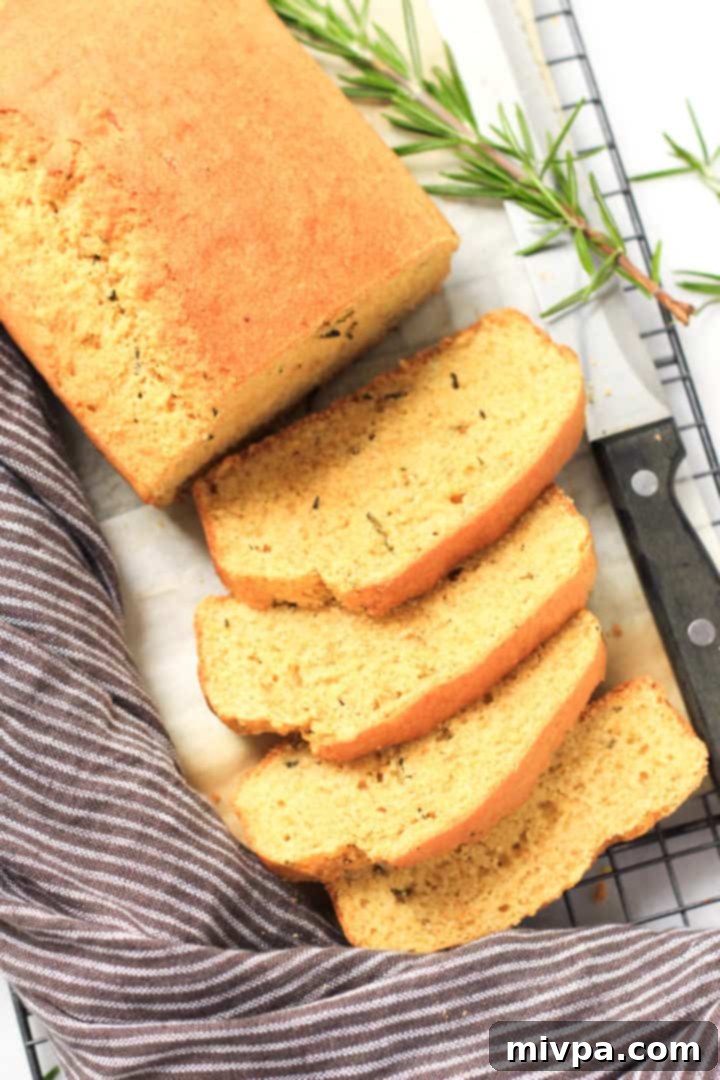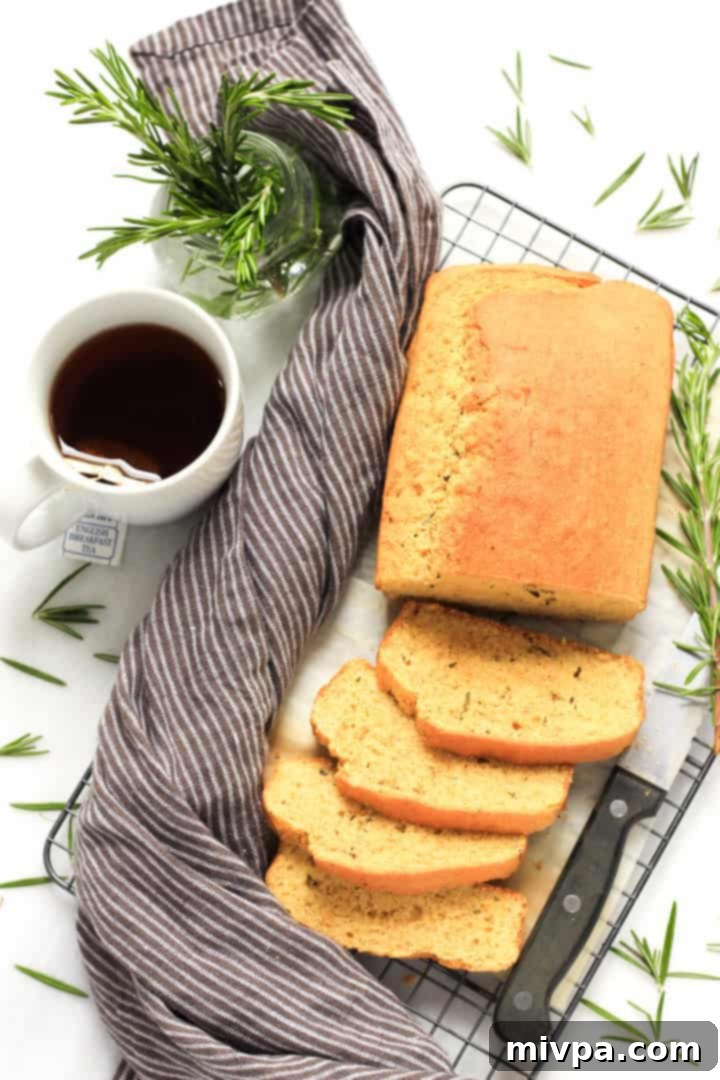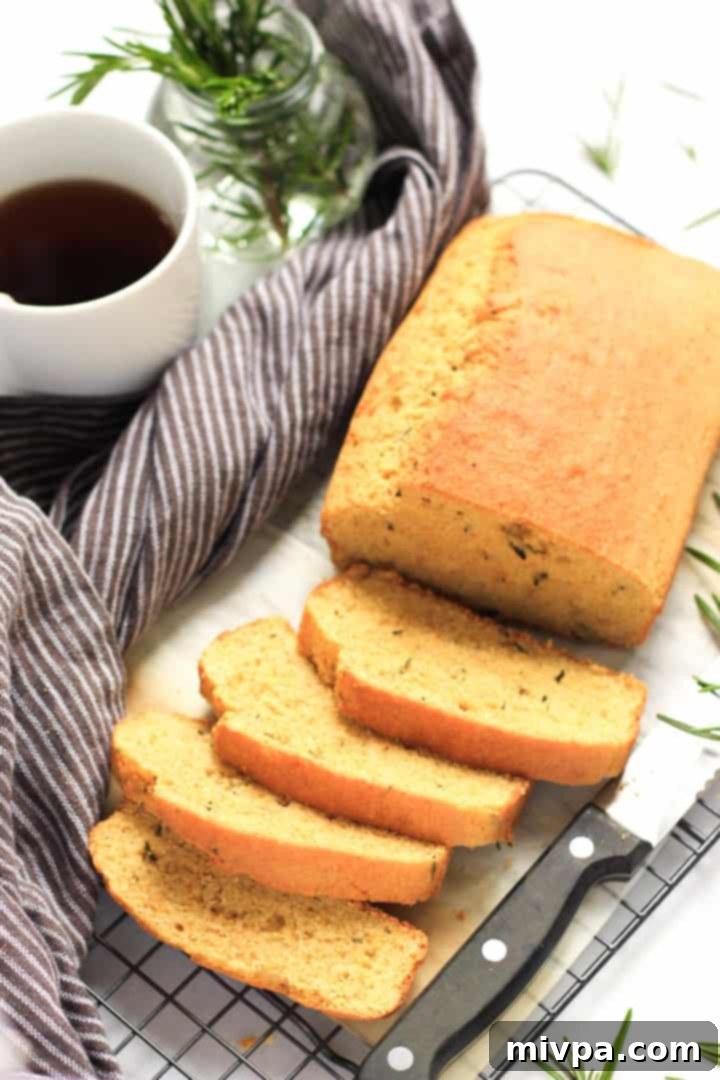Easy Gluten-Free Rosemary Cornbread: Moist, Fragrant & Dairy-Free
Prepare to be amazed by this incredibly easy and aromatic rosemary cornbread! Infused with the fresh, piney notes of rosemary, this recipe is a versatile culinary delight. It serves as a perfect comforting side for hearty chili con carne, an elegant Thanksgiving appetizer, or simply a delightful snack to enjoy on any occasion, particularly during the cozy holiday season. What makes this recipe truly stand out? It’s ready in a mere 45 minutes from start to finish, and the best part is, it’s completely gluten-free and dairy-free. You’d honestly never guess it by its wonderfully moist texture and rich, inviting flavor!

Embracing the Spirit of Gratitude and Homemade Goodness
As the holiday season approaches, bringing with it the warmth and anticipation of Thanksgiving, my thoughts often drift to feelings of deep gratitude. Despite the whirlwind of events this past year has brought, I find myself profoundly thankful for the myriad of blessings in my life. The holidays have a wonderful way of drawing me into a reflective, nostalgic mood, prompting me to recount all the things that bring me joy and goodness. It’s a constant, comforting reminder that I truly have more than enough.
Cultivating a grateful heart has a powerful, multiplying effect. When we choose to express thanks, it signifies an acknowledgement that we have already received, shifting our perspective away from scarcity and towards abundance. This mindset, in turn, seems to invite even more goodness into our lives. I’ve personally experienced this countless times, and because of that, I passionately encourage you to pause, no matter your current situation, and identify something, big or small, for which you can genuinely give thanks. This simple practice can transform your outlook and open your heart to greater joy.
And what better way to share this feeling of warmth and abundance than through homemade food? This rosemary cornbread recipe perfectly encapsulates that spirit – a comforting, delightful creation that is meant to be shared and savored with those we cherish. It’s a testament to the simple pleasures that make life so rich.

Introducing Our Delightful Gluten-Free Rosemary Cornbread Loaf
Among my absolute favorite foods to prepare during the festive season, cornbread undeniably takes a top spot. My culinary journey with cornbread has been diverse and delicious, ranging from my go-to skillet cornbread, to the zesty kick of spicy jalapeño cornbread, the convenience of easy cornbread muffins, and even the charming elegance of cornbread madeleines! Each variation brings its own unique character to the table.
Today, I am overjoyed to share a recipe that introduces a simple yet incredibly flavorful twist: a gluten-free rosemary cornbread loaf. This recipe beautifully marries the distinct, savory aroma of fresh rosemary with the comforting, slightly sweet essence of traditional cornbread. The best part? It comes together incredibly quickly, allowing you to enjoy a warm, freshly baked loaf in just 45 minutes from start to finish. While many associate cornbread with a classic cast iron skillet, baking it in a loaf pan yields a wonderfully moist and tender crumb that is equally (if not more!) delightful for slicing and sharing.
Whether you’re seeking a wholesome and satisfying snack to enjoy with a cup of coffee, a standout side dish for your holiday table, or a comforting accompaniment to a hearty meal, this gluten-free rosemary cornbread is an absolute must-try. Its unique flavor profile is sure to make it a new favorite in your home. Trust me on this one – bake it, share it, and savor every tender bite!
Why This Rosemary Cornbread Recipe is a Must-Make:
- Simple, Accessible Ingredients: You won’t need to hunt for exotic items or make a special trip to a gourmet store for this recipe. All the ingredients required for this delicious gluten-free rosemary cornbread are easily found at your local grocery store. We believe that exceptional homemade food should be accessible to everyone, without any unnecessary fuss or complicated shopping lists.
- Effortlessly Easy to Prepare: Whether you’re a seasoned baker or just starting out, this recipe is designed for simplicity. With minimal prep time, the cornbread batter comes together quickly by simply combining the wet and dry ingredients. The oven handles the rest, baking it to golden perfection. This straightforward process makes it an ideal recipe for busy weeknights or when you need a reliable dish in a pinch.
- Perfectly Gluten-Free & Dairy-Free with No Compromise on Taste or Texture: This is truly where this recipe shines! This easy rosemary cornbread is 100% gluten-free and dairy-free, making it suitable for those with Celiac disease, gluten sensitivities, or lactose intolerances. The incredible secret is that you would honestly never know it’s free from gluten and dairy! We’ve crafted it to ensure a wonderfully moist, tender crumb and rich flavor, proving that dietary restrictions absolutely do not mean sacrificing deliciousness.
- Quick to the Table in Just 45 Minutes: In our busy lives, finding time for homemade baking can sometimes feel daunting. This recipe respects your schedule, delivering a warm, fragrant loaf of cornbread in just 45 minutes from start to finish – that includes both preparation and baking time! It’s perfect for a quick side dish, a spontaneous snack, or a last-minute addition to your holiday spread.
- Incredibly Versatile for Any Occasion: The unique savory-sweet profile of this rosemary cornbread makes it highly adaptable. Serve it as a hearty side with a savory stew, a comforting bowl of chili, or a roasted chicken. It’s also fantastic on its own as a wholesome snack, drizzled with a little honey, or even as a unique appetizer for holiday gatherings.

Essential Ingredients You’ll Need + Notes/Substitutions:
Below is a comprehensive overview of the ingredients required for this delightful rosemary cornbread recipe, complete with important notes and helpful substitution options to ensure your baking experience is a resounding success.
(For exact measurements of each ingredient, please refer to the printable recipe card conveniently located at the bottom of this post.)
- Cornmeal: For this recipe, I achieved fantastic results using a medium-grind yellow cornmeal, which contributes a pleasant, slightly rustic texture to the cornbread. However, if you only have access to a fine-grind cornmeal, it will work just as wonderfully, resulting in a slightly smoother, more uniform crumb.
- Gluten-Free All-Purpose Flour: The choice of your gluten-free flour blend can significantly impact the final texture of your baked goods. I highly recommend using a good-quality gluten-free all-purpose flour blend that is primarily composed of lighter flours and starches, such as rice flour, potato starch, tapioca starch, or cornstarch. These types of blends tend to produce a lighter and more tender crumb. Conversely, I strongly advise against using gluten-free flour blends that are predominantly made of heavier, denser flours like garbanzo bean flour (chickpea flour) or other legume-based flours, as these can lead to a cornbread that is dense, gummy, gritty, and may even have an undesirable flavor.
- Baking Powder: This ingredient is a vital leavening agent, crucial for helping the cornbread batter rise and achieve its light, fluffy texture. Always ensure your baking powder is fresh and active for optimal results. If you have Celiac disease or a gluten intolerance, it is important to verify that you are using certified gluten-free baking powder to prevent any potential cross-contamination.
- Rosemary: Rosemary is truly the star flavor in this recipe, lending a wonderfully aromatic, piney, and savory note to the cornbread. I prefer using fresh rosemary for its vibrant taste and fragrance. If fresh rosemary is not available, you can substitute with dried rosemary. Remember that dried herbs are significantly more potent than fresh ones, so use only about one-third of the amount called for with fresh herbs (e.g., if the recipe specifies 1 tablespoon fresh, use 1 teaspoon dried).
- Eggs: Eggs play a crucial role in this recipe by acting as a binder, holding the ingredients together, and contributing to the batter’s lift and moisture, creating a tender crumb. I have not personally tested this recipe with egg substitutes, so I cannot guarantee the outcome. However, if you have an egg allergy, you might try experimenting with alternatives such as aquafaba (the liquid from a can of chickpeas) or a commercial egg replacer. If you do successfully make this recipe egg-free, please be sure to let me know how it goes in the comments below – I’d love to hear about your experience!
- Sugar: White granulated sugar provides a balanced and pleasant sweetness to this cornbread. However, you have several options for customization! You can use cane sugar, light brown sugar (which adds a subtle molasses flavor), dark brown sugar (for deeper caramel notes), or coconut sugar (for an earthy, less refined sweetness). Just keep in mind that using darker sugars will result in a slightly darker-colored cornbread. For those managing blood sugar, I highly recommend using granulated monkfruit sweetener, which is a fantastic 1:1 sugar substitute with a zero glycemic index that won’t raise your blood sugar levels.
- Almond Milk: I prefer to use an unsweetened version of my 5-minute homemade almond milk, but any unsweetened store-bought almond milk will work perfectly. You can also successfully use other unsweetened non-dairy milks, such as cashew milk, rice milk, oat milk, or coconut milk (from a carton, not canned). If you are not lactose-intolerant, feel free to use regular dairy milk in equal amounts.
- Coconut Oil: For baking and cooking, I typically opt for refined coconut oil because it has a neutral flavor that won’t overpower the delicate taste of the rosemary and cornmeal. Extra virgin coconut oil retains a distinct coconut flavor, which may or may not be desired in this recipe. If you have a coconut allergy, or simply prefer another fat, you can use any other neutral-flavored vegetable oil, such as light olive oil, canola oil, sunflower oil, or avocado oil. Melted dairy-free butter is also an excellent alternative. If you are not lactose-intolerant, feel free to use melted unsalted butter or ghee in the same quantities.
Step-by-Step Instructions for Baking Perfect Rosemary Cornbread:
Follow these straightforward steps to bake a perfectly moist and flavorful rosemary cornbread loaf that will impress everyone.
1. Preheat Your Oven and Prepare Your Pan
Start by preheating your oven to a precise 425°F (220°C). This ensures the oven is at the optimal temperature for even baking from the moment your batter enters. Next, take a standard 9″ x 5″ loaf pan and generously grease it, then line it with parchment paper. Allowing a slight overhang of parchment paper on the sides will create convenient “handles,” making it incredibly easy to lift the finished cornbread out of the pan once baked. If parchment paper isn’t on hand, a thorough spray with a nonstick cooking spray will also suffice.
2. Whisk the Dry Ingredients Together
In a medium-sized mixing bowl, combine your cornmeal, gluten-free all-purpose flour, and baking powder. Add the finely chopped fresh rosemary. Use a whisk to thoroughly combine these dry ingredients. This step is crucial for ensuring that the leavening agent (baking powder) and the aromatic rosemary are evenly distributed throughout the mixture, guaranteeing a consistent rise and flavor in every slice of your cornbread.
3. Beat the Wet Ingredients Until Combined
In a separate, larger mixing bowl, gently beat the eggs, granulated sugar, almond milk, and melted coconut oil. Mix these wet ingredients together until they are just combined and smooth. There’s no need to overmix at this stage; simply ensure all the liquid components are well incorporated.
4. Prepare the Cornbread Batter
Slowly and carefully add the whisked dry ingredients into the bowl containing the wet ingredients. Mix until a homogeneous batter is achieved. The key here is to mix just until no streaks of dry flour remain. Overmixing, even with gluten-free flours, can sometimes lead to a tougher texture in your baked goods, so stop as soon as everything is incorporated.
5. Bake & Cool for Optimal Texture
Pour the prepared cornbread batter evenly into your greased and lined loaf pan. Transfer the pan to your preheated oven and bake for approximately 30 minutes. To confirm doneness, insert a clean toothpick into the very center of the loaf; if it comes out clean or with a few moist crumbs attached (but no wet batter), your cornbread is ready. Once baked, allow the rosemary cornbread loaf to cool in the pan for 10 minutes. This resting period is important as it helps the cornbread firm up and become easier to handle. After 10 minutes, carefully lift it from the pan using the parchment paper overhangs and transfer it to a wire rack to cool completely before slicing into pieces. Cooling on a wire rack ensures air circulates around the entire loaf, preventing any sogginess on the bottom.
6. Drizzle and Serve Your Delicious Creation
Once your fragrant rosemary cornbread has cooled to your preferred temperature, slice it into generous portions. For an extra layer of sweetness and moisture, serve it with a generous drizzle of golden honey or pure maple syrup. A dollop of dairy-free butter (or regular butter, if not dairy-free) also makes a wonderful accompaniment. This cornbread is truly delightful on its own, but these simple additions can elevate the experience beautifully. Enjoy every comforting bite!

Dish by Dish Pro Tips & Expert Tricks:
- Fresh versus Dried Herbs: Mastering Flavor Intensity: While fresh rosemary imparts the most vibrant, complex, and aromatic flavor to your cornbread, dried rosemary is a perfectly acceptable and convenient substitute. The key is understanding the difference in potency: dried herbs are significantly more concentrated than their fresh counterparts. As a general rule, when substituting dried for fresh, use approximately one-third of the amount specified for fresh herbs. For example, if the recipe calls for 1 tablespoon of fresh rosemary, use just 1 teaspoon of dried. To further enhance the flavor of dried rosemary, gently crush it between your fingers before adding it to the batter; this helps release its fragrant essential oils.
- Explore Alternative Herbs for Unique Flavor Profiles: Don’t feel confined to rosemary alone! This cornbread recipe is wonderfully versatile and can be adapted with other savory herbs. Consider swapping out the rosemary for finely chopped fresh thyme, which offers a lovely earthy and slightly citrusy note. Alternatively, fresh oregano can provide a bolder, peppery undertone. A blend of herbs like sage and thyme can also create a fantastic, nuanced savory profile, making it an excellent pairing, especially for holiday meals.
- Transform the Batter into Individual Rosemary Cornbread Muffins: This delicious cornbread batter can easily be divided and baked into charming individual muffins. Simply grease the cavities of a standard muffin pan and fill them evenly with the batter. Bake them at the same oven temperature (425°F / 220°C) but for a shorter duration, typically around 20 minutes, or until a toothpick inserted into the center of a muffin comes out clean. Muffins are perfect for portion control and an attractive presentation.
- Achieve Crispy Edges with Skillet Rosemary Cornbread: If you adore the signature crispy edges that only a cast iron skillet can deliver, this recipe can be easily adapted! To make skillet rosemary cornbread, simply preheat your cast iron skillet in the oven while it’s preheating, or thoroughly grease a hot skillet on the stovetop before adding the batter. Pour the batter directly into the hot skillet and bake for 25-30 minutes, or until the top is golden brown and a wooden pick inserted into the center comes out clean. The hot skillet creates a beautifully caramelized, crispy crust on the bottom and sides.
- Perfect Pairings: What to Serve with This Savory Cornbread: This savory rosemary cornbread is an incredibly versatile side dish that pairs wonderfully with a wide array of meals. It’s truly exceptional when served alongside hearty, robust dishes such as a warm bowl of chili con carne, a creamy butternut squash soup, or a flavorful carrot soup. It also complements grilled meats, barbecued ribs, tender pulled pork, roasted chicken, or holiday turkey beautifully. For a simple breakfast or snack, enjoy it warm with a pat of butter (dairy-free if needed) and a generous drizzle of honey or maple syrup.
Frequently Asked Questions: Rosemary Cornbread FAQs:
To ensure your rosemary cornbread remains fresh and moist, it’s crucial to allow it to cool completely to room temperature before storing. Once cooled, place the entire loaf or individual slices in an airtight container or wrap it tightly in plastic wrap. It can be stored at room temperature for up to 2-3 days, or in the refrigerator for up to 5 days. For the best flavor and texture, I recommend gently warming it slightly before serving.
Absolutely, this rosemary cornbread freezes exceptionally well, making it a fantastic option for meal prep or enjoying a homemade treat later! Once the cornbread has fully cooled to room temperature, wrap it tightly (unsliced is often best for freezing, if possible) in multiple layers of plastic wrap, followed by an additional layer of aluminum foil. This double-wrapping technique helps to prevent freezer burn. Alternatively, you can place it in a freezer-safe airtight container. It can be stored in the freezer for up to two to three months. When you’re ready to enjoy, simply transfer the frozen cornbread to the refrigerator overnight to thaw completely. Once thawed, you can warm it gently in the oven (covered with foil to prevent drying) or in the microwave before slicing and serving. This method ensures it retains its delightful moist texture and rich flavor.

Discover More Gluten-Free Cornbread Favorites:
- Spicy Jalapeño Cornbread (Gluten-Free, Dairy-Free)
- Classic Gluten-Free Skillet Cornbread (Dairy-Free)
- Easy Sweet Corn Cornbread Muffins (Gluten-Free, Dairy-Free)
- Delightful Blueberry Cornbread Muffins (Gluten-Free)
- Elegant Cornbread Madeleines (Gluten-Free)
Explore More Gluten-Free Thanksgiving and Holiday Recipes:
- 126 Gluten-Free Desserts and Sweet Treats for Labor Day
- 94 Savory Gluten-Free Recipes for Labor Day Weekend
- Gluten-Free Chocolate Chip Pumpkin Bread (Dairy-Free)
- Gluten-Free Pecan Pie Bars (Dairy-Free)
P.S. If you try this incredible rosemary cornbread recipe, I would be absolutely thrilled if you could leave a star rating below and/or a review in the comment section further down the page. Your feedback is invaluable and always deeply appreciated! Don’t forget to explore my entire Recipe Index for a treasure trove of delicious recipes on the blog. You can also connect with me and find more culinary inspiration on Pinterest, Facebook, or Instagram! And for fresh recipes delivered directly to your inbox each week, be sure to sign up for my exclusive Email List!
Print

Rosemary Cornbread Recipe (Gluten-Free, Dairy-Free)
5 Stars 4 Stars 3 Stars 2 Stars 1 Star
5 from 3 reviews
Author: felicia | Dish by Dish
Total Time: 45 minutes
Yield: 1 loaf
Diet: Gluten Free
Description
This easy rosemary cornbread recipe is flavored with fragrant rosemary, and makes a perfect side with chili con carne, as a Thanksgiving appetizer, or simply an anytime snack to enjoy during the holiday season. Ready in just 45 minutes, it’s also totally gluten-free and dairy-free, but you honestly wouldn’t know it!
Ingredients
Units
Scale
- 1 cup yellow cornmeal
- 1 cup gluten-free all-purpose flour
- 1 1/2 teaspoons baking powder
- 1 tablespoon finely chopped fresh rosemary
- 2 large eggs, lightly beaten
- 1/3 cup sugar
- 1 cup almond milk
- 1/3 cup melted coconut oil
Instructions
- Preheat and Prepare Pan: Pre-heat oven to 425F (220C). Grease and line a standard 9″ x 5″ loaf pan with parchment paper.
- Whisk Dry Ingredients: In a medium bowl, combine cornmeal, gluten-free all-purpose flour, baking powder, chopped rosemary and whisk well.
- Beat Wet Ingredients: In a large bowl, beat eggs, sugar, almond milk and melted coconut oil until combined.
- Prepare the Batter: Slowly add in the dry ingredients to wet ingredients and mix well until a homogeneous batter is achieved.
- Bake: Pour batter into prepared loaf pan and bake for 30 minutes or until a toothpick inserted in the middle comes out clean.
- Cool: Allow the rosemary cornbread loaf to cool for 10 minutes before removing from pan and then letting it cool some more on a wire rack before slicing into pieces.
- Serve: Serve with a drizzle of honey or eat alone.
Notes
Cornmeal: I used a medium-grind yellow cornmeal, but a finer texture will work just as well.
Gluten-Free All-Purpose Flour: I recommend using a good-quality gluten-free all-purpose flour blend (that is made up of lighter flours/starches such as rice flour, potato starch, tapioca starch, cornstarch) as it tends to give baked goods a lighter texture. I do NOT recommend using a gluten-free flour blend made up of heavier flours (such as garbanzo bean flour) as it results in a denser, gummier, or even gritty texture and can impart an undesirable flavor.
Baking Powder: Baking powder is the only leavening agent that will help the batter rise, so make sure you add it in. If you are Celiac or gluten-intolerant, make sure to use certified gluten-free baking powder.
Rosemary: Rosemary is the star ingredient here, and I used fresh rosemary, but you may also use a third of the amount of dried rosemary instead.
Eggs: Eggs help to bind the ingredients together and gives the batter lift. I personally have not tried making this recipe without eggs, so I don’t know how it would turn out. However, if you are allergic to eggs, you may try using acquafaba or an egg-replacer (if you do make this egg-free, please let me know how it goes in the comments below, I’d love to know!).
Sugar: I used white sugar, but you can also use cane sugar, light brown sugar, dark brown sugar or coconut sugar if you prefer (just bear in mind that the darker the sugar used, the darker the color of the cornbread). If you are diabetic of insulin-resistant, I highly recommend using granulated monkfruit sweetener (a 1:1 sugar substitute that is zero glycemic index and will not raise your blood sugar).
Almond Milk: I like using an unsweetened version of my 5-minute homemade almond milk, but you can also use any unsweetened non-dairy milk (such as cashew milk, rice milk, oat milk, or coconut milk). Alternatively, if you are not lactose-intolerant, feel free to use regular milk too if you prefer.
Coconut Oil: I like using refined coconut oil for baking and cooking because it has a more neutral taste compared to extra virgin coconut oil. If you are allergic to coconut, you can also use another neutral vegetable oil (such as light olive oil, canola oil, sunflower oil, avocado oil) or even melted dairy-free butter. Alternatively, if you are not lactose-intolerant, feel free to use melted butter or ghee in equal amounts.
Storing/Freezing: To store, place the rosemary cornbread in an airtight container or wrap in plastic wrap and store in the refrigerator for up to 5 days. To freeze, wrap the cornbread in various layers of plastic wrap and then foil, and freeze for up to two months. Let the gluten-free rosemary cornbread thaw completely overnight in the refrigerator before slicing into pieces and serving, or gently reheat from frozen for a quicker option.
This recipe was originally posted in 2015 and has been republished to include clearer step-by-step instructions, more detailed recipe notes, and comprehensive substitution options.
Barely adapted from: Alida’s Kitchen
- Prep Time: 15 mins
- Cook Time: 30 mins
- Category: Bread
- Method: Baking
- Cuisine: American
